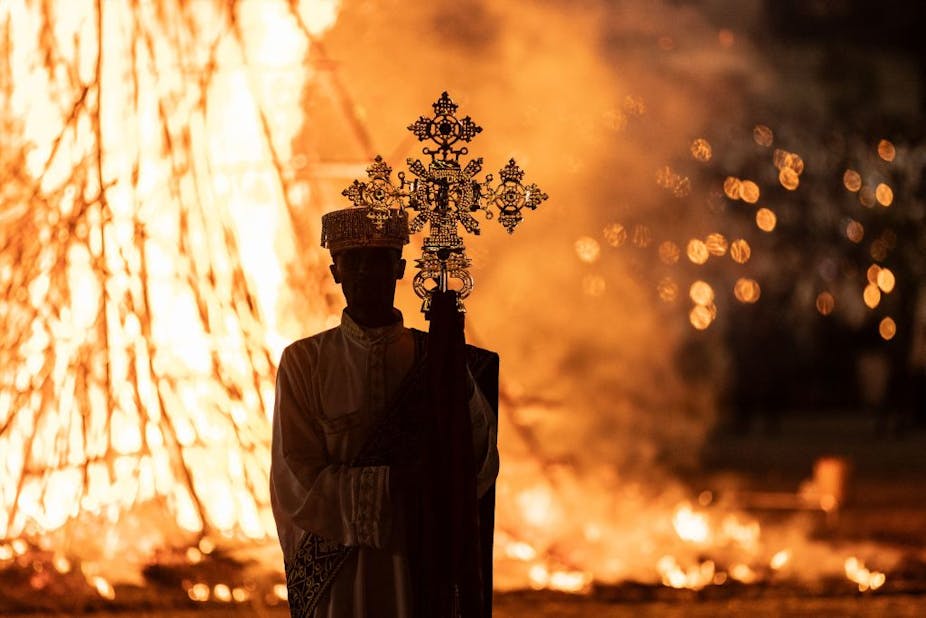Religion is highly present in Ethiopia. It’s visible in churches and mosques, in clothing, and in public rituals.
The country’s main religious communities are Orthodox Christians, Muslims and Protestants. It’s home to one of the world’s oldest churches and has the third-largest Muslim population in sub-Saharan Africa. Orthodox Christians account for about 43% of the population, while approximately 33% are Muslims. Protestant Christianity arrived in the late 19th century and has expanded rapidly in recent decades to account for an estimated 20% of the population.
Ethiopia is often portrayed as a unique case of harmonious inter-religious relations where Christians and Muslims have lived peacefully together for centuries. But the country has also seen religious conflicts.
In the last three decades, there has been a worsening of religious tension. In 2022, for instance, more than 20 people were killed following attacks on Muslims in the north-western city of Gondar.
Ethiopia is constitutionally a secular state. Religion has no formal place in politics. Shared spaces and government buildings are to be free from any religious expressions. However, this has been unevenly practised. Religion is present everywhere.
I am a scholar of religion, with extensive fieldwork and research experience in religion, ethnicity and politics in Ethiopia. In a recent paper, I analysed the developments over the last decades that have affected inter-religious relations, worsened polarisation and produced conflicts.
In my view, five factors have contributed to the rise in religious tensions.
First, the political transition in 1991, which allowed for greater expression of religious activities and changed the religious landscape. Second, the expansion of Christian Protestantism from the early 1990s. Third, the rise of a more visible and assertive Muslim population. Fourth, the response from the Ethiopian Orthodox church to a loss of influence. Finally, Prime Minister Abiy Ahmed allowing religion to enter the public political discourse.
Growing conflict
Civil war and ethnic conflicts have dominated news coming out of Ethiopia in recent years. Religious and ethnic identities are closely connected, but the ethnic dimension of conflict has tended to overshadow the growing tensions between religious communities.
In 2018, young rioters burned churches and killed several priests in Jijiga, in the eastern Ethiopian state of Somali. In 2020, Muslim properties were attacked in Harar, eastern Ethiopia, during celebrations of an Orthodox Christian holiday. In 2022, attacks on Muslims in Gondar turned deadly. Such incidents have eroded trust between Ethiopia’s religious communities.
Inter-religious violence is often blamed on so-called extremist elements. However, a closer look reveals a more complex picture.
The drivers
The political transition in 1991 and the arrival of the Ethiopian People’s Revolutionary Democratic Front led to important changes to the political, social and cultural landscape. Seeking to promote equal rights for the country’s ethnic and religious groups, the new government lifted formal restrictions on religious activities.
This affected the balance of power between religious groups. Historically, Ethiopia’s inter-religious co-existence was made possible by one community dominating the others.
Since its establishment in the fourth century, the Ethiopian Orthodox Church had been intimately tied to the state. The domination of the church contributed to the marginalisation of other religious communities. The 1974 Ethiopian Revolution ended the state-church marriage, and the changes after 1991 further eroded the church’s position and brought other religious communities in from the shadows.
The second driver of tensions has been the rise of Protestantism. Initially brought by western missionaries in the late 19th century, the religion was mainly found in Ethiopia’s non-Orthodox southern region. Protestantism grew rapidly after 1991, with churches and ministries expanding into traditional Orthodox and Muslim areas. On occasion, this has led to violent conflict. In 2006 and 2010, for instance, clashes erupted in the southwestern area of Jimma.
Read more: Religion was once Ethiopia's saviour. What it can do to pull the nation from the brink
The 1991 changes also led to Islam becoming more visible in the country. Various Islamic reform movements began strengthening religious identity among Muslims and countering their historically marginalised position. This produced a more assertive community. Muslims have become more active in Ethiopia’s social and political life. Numerous mosques have been built across the country. And Muslims have become increasingly visible through a changing dress code, particularly the use of veiling among women, and through public celebrations of religious holidays.
Many Christians, both Orthodox and Protestant, interpret a more visible and assertive Muslim community as proof of Islamic “extremism”. It’s commonly claimed that mosques and religious schools are funded by Saudi Arabia. And that the ultimate aim of Ethiopia’s Muslims is political power.
Research has shown that Saudi religious activism has actually dwindled over the last years. But the narrative about such ties continues to fuel suspicions and affect Christian-Muslim relations.
All these developments have been challenging for the Orthodox church. Many of its members are changing their affiliation to Protestantism. The Orthodox church has made efforts to limit this. It has, for instance, prohibited the construction of Protestant churches and mosques in Lalibela and Axum in Ethiopia’s north. The church has declared these cities as sacred Orthodox spaces.
The Orthodox church has also sought to reclaim its lost space by, for example, celebrating religious holidays through highly visible ceremonies. During its Meskel holiday in September this year, the Addis Ababa government placed restrictions on the celebration.
The church’s responses have provoked reactions among other religious communities, particularly Muslims who view its actions as an attempt to curb the space they have carved out for themselves.
Finally, Abiy’s political language is laced with semi-religious references. The prime minister is a practising Pentecostal. His acknowledgement of religion has enabled actors to lift religion into the public sphere in ways that have sharpened boundaries and added to the tensions.
Way forward
Religious identities and belonging are important in today’s Ethiopia. Changes over the last decades have, however, deepened inter-religious tensions. There is potential to alleviate these tensions. Doing this will require political and religious leaders to communicate across religious boundaries to accommodate Ethiopia’s plurality.

